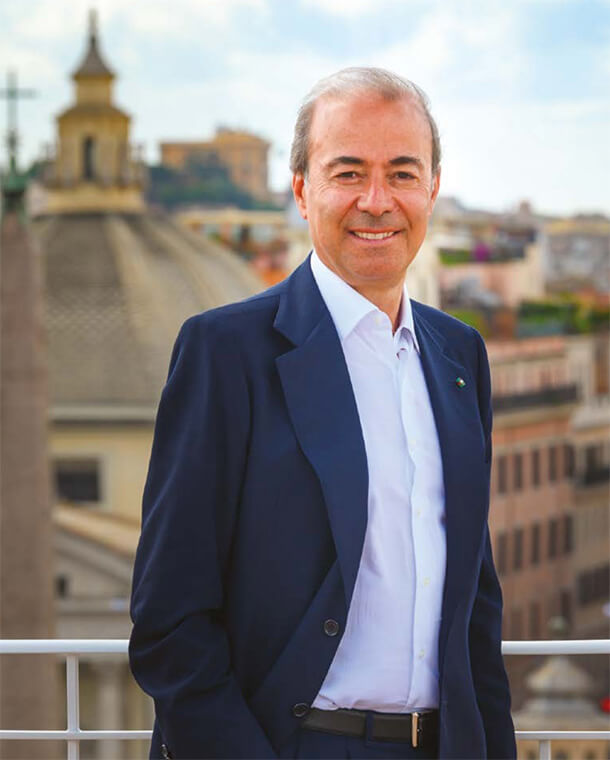
Every stone in Rome is a lesson in engineering, every ancient wall a challenge for the future. In this thousand-year-old city, the dialogue with the past is uninterrupted, almost physical: it accompanies us in our daily gestures, questions the meaning of our actions, inspires us. It is precisely from this dialogue that the book in-genium was born, a photographic and conceptual project promoted by MAIRE and its Foundation, in collaboration with the Parco archeologico del Colosseo. A journey through images and ideas, discovering a deep connection between the technical knowledge of the ancients and the sustainable innovation that guides our Group today.
With in-genium, we wanted to show how the legacy of human ingenuity which made it possible to build aqueducts, ports, roads, and cities that have stood for thousands of years continues to live on in the principles that guide our industrial vision. Technology, art, philosophy, and archaeology are interwoven in a work that is not only aesthetic contemplation, but also collective reflection. Because every technology, even the most advanced, always stems from a simple idea: to improve human life and create lasting value.
Within the pages of this new issue of EVOLVE, you will find some of the images taken from in-genium. They are profound glimpses into the past, but with an eye toward the future. We wanted to involve young talents from Italian Academies of Fine Arts to take on this visual and cultural challenge, asking them to represent the engineering of yesterday, today, and tomorrow. It is a concrete sign of our desire to build generational and cultural bridges, to cultivate a new technical imagination capable of combining beauty with functionality, sustainability with social impact.
As President of MAIRE, I firmly believe that industry must be able to educate, inspire, and influence. This is precisely why in this issue of EVOLVE we have chosen to feature a project that has its roots in history but looks far ahead. Because the future is built on the living memory of the past. And ingenuity – the authentic kind, the kind that transforms the world – is timeless.
In our way of thinking and operating, innovation is not a goal to be achieved: it is a method, a mindset, a daily habit. At MAIRE, every project, every decision, every team is called upon to contribute to a continuous evolutionary process that runs through all levels of the organization, from technological research to human capital management. The motto around which this issue is focused is #Inspire Innovation: innovation is in everything we do. » This is not a slogan, but a shared commitment that is deeply rooted in our culture and in our way of doing business.
Innovating means more than inventing. It means creating real, measurable value that is useful to those who will use a technology, a system, or a solution. And to do this, we must abandon the idea that innovation is the prerogative of a few experts or top execu- tives. On the contrary, it is a collective and cross-cutting process that also comes from freedom to engage in critical thinking and from a diversity of points of view. The most disruptive insights do not always come from where we expect them to. And it is often exactly this intermingling – between generations, skills, and cultures – that generates real change.
At this moment in history, when our industry is redefining its role in response to the challenges of the energy transition, it is essential for a technology company like ours to have a "home for innovation." With this in mind, we have created the Green Innovation District in Rome, our new hub of excellence that will host laboratories, industrial research activities, advanced experiments, and pilot plants. It is here that we will develop technological solutions, validating their industrial scalability and competitive value with the aim of bringing them to market quickly.
But innovation is not limited to the technical sphere. It also concerns the way we approach markets, analyze customer needs, and structure our offerings. Every new technology must be born with a clear idea of its strategic positioning, the value it can generate, and the change it can bring about. At MAIRE, technological thinking is always accompanied by an economic and social vision capable of guiding specific, long-term choices.
This vision would not be possible without people. Without the courage of those who accept risk, who know how to deal with uncertainty, who question the status quo. It is not age that defines who can innovate, but the spirit with which we measure ourselves against reality. This is the attitude we seek, cultivate, and value throughout our ecosystem today. Because only with an open, critical, and curious gaze, can we truly build an industrial future that meets the challenges of our time. It is with this in mind that we are committed to the challenge of building a new ITS Foundation, which we are launching with the idea of training young people for the new professions of the energy transition.
During the recent Capital Markets Day, I wanted to share not only results and projections with our stakeholders, but above all a vision. "Frame Forward," the title chosen for the event, was an invitation to frame the future, to de"ne it through the concrete actions we are taking today. Innovation, in fact, also means knowing how to change what works, having the courage to continuously evolve even in the midst of success. That is why our Capital Markets Day is renewed every year, taking on a different form, becoming an eagerly awaited event by all, rich in content and new ideas. I showed tangible examples – from the hydrogen-powered bicycle to our plastics upcycling plant and the NX FHYVE™ electrolyzer – to explain how technology can be translated into accessible, affordable, scalable solutions capable of generating real impact in everyday life.
Today, MAIRE is a unique player in the international arena: we combine the operational experience of TECNIMONT with the sustainable technology of NEXTCHEM. This integration allows us to offer complete solutions for the energy transition, adaptable to different geographical and geopolitical contexts. The numbers speak for themselves: by 2029, we expect to reduce direct emissions by 37%, achieving carbon neutrality. And thanks to our technologies, around 700,000 tons of CO₂ have already been prevented. But in addition to our environmental goals, we want to help reignite great industrial ambitions in Italy. We want to bring chemical excellence back to our country, build a competitive technological ecosystem, and train young professionals capable of driving change.
This is our challenge, but also our responsibility: to combine ingenuity and vision to leave a lasting mark. Because only those who can imagine the future can have the courage to build it.

This is our challenge, but also our responsibility: to combine ingenuity and vision to leave a lasting mark. Because only those who can imagine the future can have the courage to build it.
Fabrizio Di AmatoFounder and Chairman of the MAIRE groupISSUE 12 – June 2025
The job of the designer, to borrow a marvelous phrase from Peter Drucker, is «converting need into demand».
[Tim Brown]
In a wicked world, relying upon experience from a single domain is not only limiting, it can be disastrous.
[David Epstein]
Technological tensions are often heightened by perceptions that the benefits of new technologies will accrue only to small sections of society while the risks will be more widely distributed.
[Calestous Juma]
The methods used to fight coffee in the Middle East (in the 16th century) are very similar to the methods used to fight GMOs in the modern day.
[Calestous Juma]
The risks of doing nothing may outweigh the risks of innovating.
[Calestous Juma]
Fail early to succeed sooner.
[Tim Brown]
Design thinking starts with divergence- the deliberate attempt to expand the range of options rather than narrow them.
[Tim Brown]
Much of the concern is driven by perceptions of loss, not necessarily by concrete evidence of loss.
[Calestous Juma]
There is nothing more frustrating than coming up with the right answer to the wrong question.
[Tim Brown]
We learn who we are in practice, not in theory.
[David Epstein]
If an idea becomes a piece of private property, it is likely to grow stale and brittle over time.
[Tim Brown]
The more confident a learner is of their wrong answer, the better the information sticks when they subsequently learn the right answer.
[David Epstein]
The quickest way to find out who your enemies are is to try doing something new.
[Calestous Juma]
Exploration is not just a whimsical luxury of education; it is a central benefit.
[David Epstein]
It is difficult to accept that the best learning road is slow, and that doing poorly now is essential for better performance later.
[David Epstein]
Excerpts from:
• David Epstein, "Range: Why Generalists Triumph in a Specialized World", Riverhead Books
• Calestous Juma, "Innovation and Its Enemies: Why People Resist New Technologies", OUP Usa
• Tim Brown, "Change by Design: How Design Thinking Transforms Organizations and Inspires Innovation", HarperBusiness
THINK BIG, ACT WITH EMPATHY
THE MAIRE TECNIMONT GROUP MAGAZINE EDITED BY Group Institutional Relations, Communication & Sustainability
Court of Milan registration - N.338 on the 06/12/2017
Carlo Nicolais
EDITORIAL COORDINATOR
Massimo Dapoto
PROJECT AND DESIGN
Cultur-e www.cultur-e.it
EDITOR
Maire Tecnimont Spa
Registered Office
Viale Castello della Magliana, 27 - 00148 Roma - Italia Operative Headquarters
Via Gaetano De Castillia, 6A - 20124 Milano – Italia
Issue completed: december 2024
The rights due for published texts are available for all parties that we were not able to contact.













